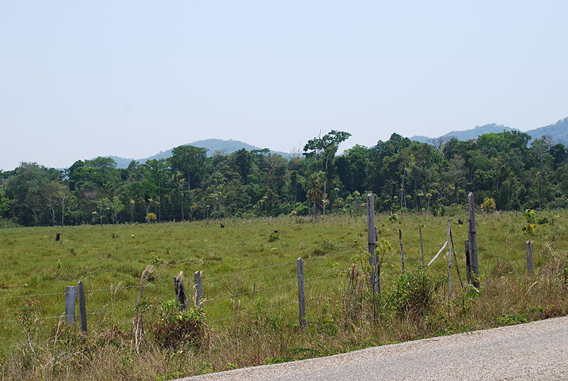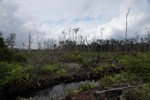
Pasture with rainforest behind in the Lacandon rainforest. Photo by: Alejandro Linares Garcia.
Tropical reforestation is not easy, especially in abandoned pasturelands. But a new study in mongabay.com’s open access journal Tropical Conservation Science finds that removing grasses prior to and after planting native tree seeds significantly improves the chances of forests to take root. The study site, located in Mexico’s Lacandon rainforest, was covered in an invasive African grass (Cynodon plectostachyus).
“Across the tropics, millions of hectares of forest have been converted to cattle pasture and then abandoned. Invasive alien grass species such as Cynodon plectostachyus, and many others originally introduced as pasture plants, commonly form dense, monospecific stands in tropical pastures […] As a consequence, vast areas of the tropics are now characterized by agricultural mosaics of pastures and fields interrupted by occasional forest remnants, a scenario that presents significant new challenges to conservation and restoration,” the researchers write.
After burning the field site, researchers planted 960 seedlings of 16 species, including a broad range of tropical tree types. Eighteen months later, they found that removing grass before and after planting significantly improved the chances of many of the species.
“Survival and growth rates of tree species always increased significantly with more intense grass removal treatments, and trees receiving less frequent treatments suffered greater mortality and lower growth,” the researchers write.
However, even though the tree seedling had greater success after grass removal, the scientists caution that the process makes reforestation more expensive. The Lacandon reforestation project cost $1,260 per hectare.
“For the time being, it is clear that legal incentives and economic support will be needed to assist restoration interventions, starting with seed collecting and nursery costs, and extending right though to planting and post-planting site maintenance such as the grass removals described here,” the researchers write.
CITATION: Román-Dañobeytia, F. J., Castellanos-Albores, J., Levy-Tacher, S. I., Aronson, J., Ramírez-Marcial, N., Rodrigues , R. R. 2012. Responses of transplanted native tree species to invasive alien grass removals in an abandoned cattle pasture in the Lacandon region, Mexico. Tropical Conservation Science Vol. 5(2):192-207.
Related articles
U.S., others commit to restoring 45 million acres of native forests
(06/19/2012) The U.S. Forest Service joined Rwanda, a Brazilian coalition, and a Central American alliance of indigenous groups in a pledge to restore 18 million hectares (45 million acres) of native forests, reports the IUCN, a conservation group.
Indonesia to set aside 45% of Kalimantan for conservation
(01/19/2012) Indonesian President Susilo Bambang Yudhoyono (SBY) on Thursday announced a regulation that would protect 45 percent of Kalimantan, the Indonesian part of Borneo, according to a statement issued by his office.
The other side of the Penan story: threatened tribe embraces tourism, reforestation

(12/19/2011) News about the Penan people is usually bleak. Once nomadic hunter-gatherers of the Malaysian state of Sarawak on Borneo, the indigenous Penan have suffered decades of widespread destruction of their forests and an erosion of their traditional culture. Logging companies, plantation developments, massive dams, and an ambivalent government have all played a role in decimating the Penan, who have from time-to-time stood up to loggers through blockades, but have not been successful in securing recognition of legal rights to their traditional lands. Yet even as the Penan people struggle against the destruction of their homelands, they are not standing still. Several Penan villages have recently begun a large-scale reforestation program, a community tourism venture, and proclaimed their a portion of their lands a “Peace Park.”
Deforestation could be stopped by 2020

(11/28/2011) If governments commit to an international program to save forests known as REDD+, deforestation could be nearly zero in less than a decade, argues the Living Forests Report from the World Wide Fund for Nature (WWF). REDD+, which stands for Reduced Emissions from Deforestation and Degradation, is a program that would pay developing nations to preserve forests for their ability to sequester carbon. Government officials begin meeting tomorrow in Durban, South Africa for the 17th UN climate summit, and REDD+ will be among many topics discussed.
Putting people to work: restoring our ecosystems, sequestering carbon
(10/02/2011) President Obama’s sole focus of his September 8th speech to the United States Congress was job creation. He closed his speech by summoning an earlier time of promise: “President Kennedy once said, ‘ Our problems are man-made—therefore they can be solved by man. And man can be as big as he wants.’ These are difficult years for our country. But we are Americans. We are tougher than the times we live in, and we are bigger than our politics have been. So let’s meet the moment. Let’s get to work…” Inspiration is surely needed because in addition to the United States, where unemployment remains at about 9 percent, severe unemployment is found throughout the world, with Greece, Spain, and South Africa, for example, having 2011 summer unemployment rates at over 16, 20, and 25 percent, respectively.